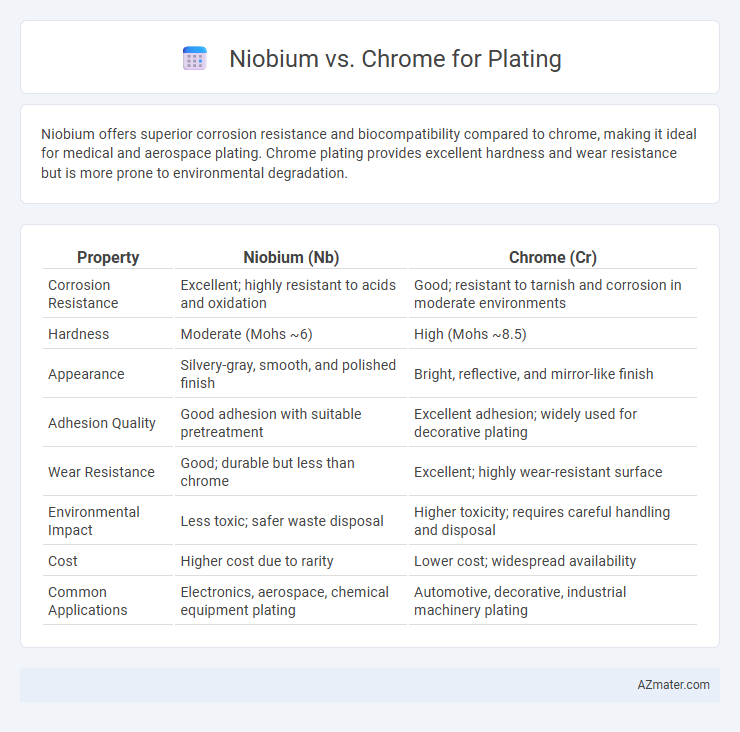Niobium offers superior corrosion resistance and biocompatibility compared to chrome, making it ideal for medical and aerospace plating. Chrome plating provides excellent hardness and wear resistance but is more prone to environmental degradation.
Table of Comparison
| Property | Niobium (Nb) | Chrome (Cr) |
|---|---|---|
| Corrosion Resistance | Excellent; highly resistant to acids and oxidation | Good; resistant to tarnish and corrosion in moderate environments |
| Hardness | Moderate (Mohs ~6) | High (Mohs ~8.5) |
| Appearance | Silvery-gray, smooth, and polished finish | Bright, reflective, and mirror-like finish |
| Adhesion Quality | Good adhesion with suitable pretreatment | Excellent adhesion; widely used for decorative plating |
| Wear Resistance | Good; durable but less than chrome | Excellent; highly wear-resistant surface |
| Environmental Impact | Less toxic; safer waste disposal | Higher toxicity; requires careful handling and disposal |
| Cost | Higher cost due to rarity | Lower cost; widespread availability |
| Common Applications | Electronics, aerospace, chemical equipment plating | Automotive, decorative, industrial machinery plating |
Introduction to Metal Plating
Metal plating enhances surface properties such as corrosion resistance, hardness, and aesthetic appeal by depositing a thin layer of metal onto a substrate. Niobium plating offers excellent chemical stability and a unique color spectrum, making it ideal for decorative and protective applications, while chrome plating is favored for its superior hardness, high reflectivity, and corrosion resistance in automotive and industrial sectors. Both materials provide critical functional and visual benefits depending on application-specific requirements.
Overview of Niobium Plating
Niobium plating offers exceptional corrosion resistance and biocompatibility, making it ideal for aerospace, medical implants, and decorative applications. Compared to chrome plating, niobium provides a more environmentally friendly and non-toxic alternative with enhanced durability under extreme conditions. Its unique ability to form a stable oxide layer improves wear resistance and electrical conductivity, distinguishing it in specialized plating industries.
Overview of Chrome Plating
Chrome plating offers exceptional hardness and corrosion resistance, making it a popular choice for automotive and industrial applications. Its mirror-like finish improves aesthetic appeal while providing wear resistance and low friction properties. Compared to niobium, chrome plating is more widely used due to its cost-effectiveness and well-established performance in protecting metal surfaces.
Key Differences Between Niobium and Chrome
Niobium plating offers superior corrosion resistance and hypoallergenic properties compared to chrome, making it ideal for sensitive skin and medical applications. Chrome plating provides a highly reflective, bright finish with excellent hardness and wear resistance, commonly used in automotive and decorative industries. While chrome is more affordable and widely available, niobium's unique ability to achieve vibrant anodized colors sets it apart for custom jewelry and high-tech uses.
Durability: Niobium vs Chrome
Niobium plating offers superior corrosion resistance and maintains its appearance longer than chrome, making it ideal for environments with high wear and chemical exposure. Chrome plating, while highly durable against scratches and abrasion, tends to suffer from chipping and corrosion over time, especially in harsh conditions. Niobium's ability to form a protective oxide layer enhances its longevity, outperforming chrome in long-term durability applications.
Corrosion Resistance Comparison
Niobium plating exhibits superior corrosion resistance compared to chrome, especially in highly aggressive environments such as acidic or saline conditions. Niobium forms a stable, adherent oxide layer that effectively protects substrates from oxidation and chemical attack, whereas chrome plating may suffer from pitting and degradation over time. The enhanced durability of niobium plating ensures longer service life and reduced maintenance costs in applications exposed to corrosive elements.
Environmental Impact and Safety
Niobium plating offers significant environmental benefits due to its non-toxic, corrosion-resistant properties and minimal hazardous waste production compared to chrome plating, which often involves hexavalent chromium known for its carcinogenic and environmentally harmful effects. Niobium's inert nature reduces the need for harmful chemicals in the plating process, enhancing worker safety and minimizing ecological contamination. Chrome plating requires extensive safety measures and waste treatment protocols to manage toxic emissions and protect human health.
Cost Analysis: Niobium vs Chrome Plating
Niobium plating generally incurs higher costs due to raw material expenses and specialized application processes compared to chrome plating, which remains more affordable and widely accessible. Chrome plating benefits from established industrial infrastructure, resulting in lower operational and maintenance costs, making it a cost-efficient choice for mass production. While niobium offers superior corrosion resistance and hypoallergenic properties, the initial investment and processing complexity often limit its use to niche markets where performance justifies the expense.
Applications and Industry Use Cases
Niobium plating offers superior corrosion resistance and biocompatibility, making it ideal for aerospace, medical implants, and electronic components where durability and non-reactivity are crucial. Chrome plating provides a hard, wear-resistant, and reflective surface, widely used in automotive, decorative hardware, and industrial tooling for both protective and aesthetic purposes. Industries requiring lightweight, corrosion-resistant coatings tend to prefer niobium, while sectors emphasizing hardness and visual appeal often select chrome.
Choosing the Right Plating Material
Niobium plating offers superior corrosion resistance and biocompatibility compared to chrome, making it ideal for aerospace and medical applications where durability and safety are paramount. Chrome plating is favored for its high hardness and brilliant shine, providing excellent wear resistance and aesthetic appeal in automotive and decorative industries. Selecting the right plating material depends on the specific requirements of hardness, corrosion resistance, biocompatibility, and visual finish of the intended application.

Infographic: Niobium vs Chrome for Plating
 azmater.com
azmater.com